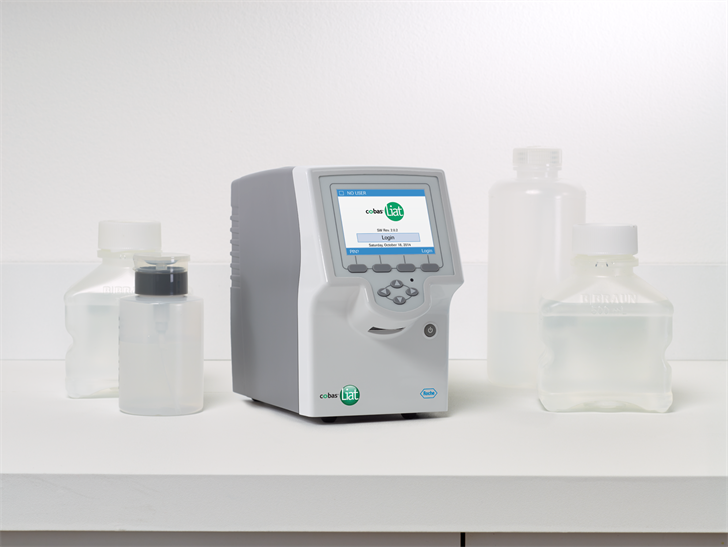Roche Works to Move Tests Out of Labs
 Roche says the next point-of-care kit in its pipeline is related to infectious disease testing in hospitals.
Roche says the next point-of-care kit in its pipeline is related to infectious disease testing in hospitals.
Subscriber Benefit
As a subscriber you can listen to articles at work, in the car, or while you work out. Subscribe NowDoctors and patients alike can relate to the waiting game for lab test results; the doctor needs clarification or confirmation of a diagnosis, orders a test and everybody waits. Assuming results are delivered in about two days, the patient may have experienced anxiety and the doctor may have lost precious treatment time. Indianapolis-based Roche Diagnostics Corp. wants to reduce the waiting game from days to minutes, and the strategy centers on point-of-care testing.
Roche Diagnostics says some 15 billion tests were performed on the company’s equipment worldwide in 2015. The conventional method involves a sample, such as blood or tissue, being sent to a large centralized lab within a hospital system. Roche Diagnostics Director of Medical and Scientific Affairs for Point of Care Dr. Corinne Fantz says these labs typically serve clinics within about a 60-mile radius and analyze about five million tests per year.
“These immunoassay-based [tests] have traditionally taken four to five hours to complete, so it might be a day or two before the provider gets the result back,” says Fantz.
Immunoassays (biochemical tests) also have poorer performance compared to high-tech lab-based molecular testing. Capitalizing on its expertise in molecular testing, Roche Diagnostics is on a mission to move the method “away from the lab and right next to the patient,” says Fantz.
Roche leaders discussed the challenge at a recent Frameworx event, hosted by the state’s life sciences initiative BioCrossroads. Developing point-of-care tests—such as load-the-sample and close-the-lid kits—means patients and doctors could have answers within minutes, instead of days.
“Getting over that threshold of really technical, complex testing that typically takes six hours in the lab and offering it at the bedside with the same level of accuracy is huge for the diagnosis of things like flu or strep,” says Fantz.
A National Hospital Ambulatory Care Survey shows strep throat is among the top 20 most-reported diagnoses for outpatient emergency department visits and accounts for more than $500 million in health care spending. Patients typically have their throat swabbed for an immunoassay-based test with “poor sensitivity,” says Fantz; the person may have strep despite a negative result from the lab, which likely took about 48 hours to process.
“Now [the doctor] is two days behind in prescribing an antibiotic; by that time, the [patient] may have infected their entire family, and the parents have missed work,” says Fantz. “There’s a huge downstream effect of not being able to have that result at the time the patient is being seen.”
Beyond infectious disease, Fantz points to other scenarios in which point-of-care testing would be beneficial, such as accident scenes. A female patient may need a CT scan of her abdomen, but paramedics must first confirm she isn’t pregnant, because radiation can harm the baby. Or having a blood test in the ambulance that can confirm a heart attack, meaning treatment could begin immediately at the hospital.
Fantz says shifting complex lab tests down to a rapid kit is riddled with challenges. Sample collection must be simple and noninvasive, the kits need to be easy enough that untrained professionals could use them and the chemistry needs to be as highly-sensitive as a lab test, but produce a result in minutes.
“Roche is looking at some infectious diseases that are high impact in hospitals and primary care clinics,” says Fantz. “Within hospitals, being able to get results back quickly is important; you can imagine things like infection control within a hospital is critical.”
Roche says it’s “doing now what patients need next.” While the company can’t share specifics about its pipeline, Fantz says Roche is developing point-of-care tests that are highly sensitive, have short turnaround times and produce results during the patient visit.
“As we move to bigger, more consolidated health systems, I see the most important testing being pushed out to the providers, so they can have results at the time of the patient visit, or even home-testing for patients with chronic diseases,” says Fantz. “I think we’re going to see huge advances in those offerings in the next few years.”
Roche is also working to develop more test kits for home use, which Fantz says is a big “patient satisfier.”
Fantz says point-of-care tests need to be simple enough that medical staff don’t need a high level of expertise.
